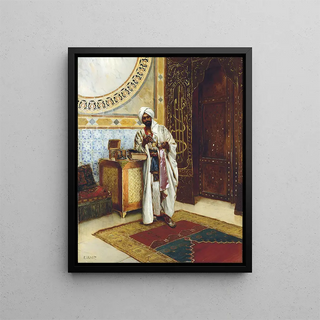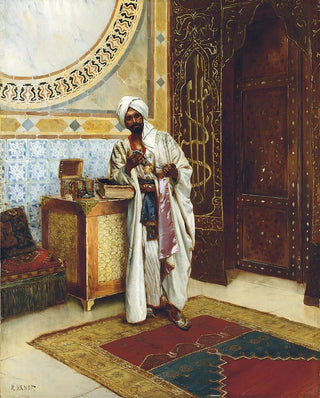Art print | The jewelry box - Rudolf Ernst


View from behind

Frame (optional)
In the world of art, some works transcend mere framing to immerse us in a universe of dreams and refinement. "The Jewelry Box" by Rudolf Ernst is one of those creations that captivates and fascinates. This piece, imbued with extraordinary delicacy, takes us on a sensory journey to the heart of the Orient. The shimmering colors, meticulous details, and intimate atmosphere conveyed by this artwork evoke a world where elegance and mystery meet. The artist, through his skill, manages to capture not only objects but also emotions, thus creating a dialogue between the viewer and the piece.
Style and uniqueness of the work
Rudolf Ernst, with his unique style, succeeds in blending realism with a touch of Oriental romanticism. "The Jewelry Box" stands out for its meticulous approach to details, where each element is carefully thought out and executed. The light reflecting on the shiny surfaces of the jewelry and the texture of the fabrics are rendered with such precision that they seem almost tangible. The work exudes an atmosphere of serenity and intimacy, inviting the viewer to immerse themselves in a moment suspended in time. The warm, rich colors, typical of the Orient, add an extra dimension to this composition, creating a harmonious balance between shadow and light. The scene depicts not only objects but also a visual narrative that evokes ancient stories, tales of the Thousand and One Nights, and unreachable dreams.
The artist and his influence
Rudolf Ernst, born in 1854 in Vienna, is an artist whose career is marked by a fascination with the Orient. Influenced by his travels through the Arab world, he was able to incorporate various cultural and artistic elements into his work. Ernst is often regarded as a master of the Orientalist genre, a movement that reached its peak in the 19th century. His works, including "The Jewelry Box," testify to a deep understanding of traditional craftsmanship and Oriental aesthetics. By immersing himself in these influences, he managed to create a style that is uniquely his own, combining a realistic approach with a refined sensibility.

Matte finish

View from behind

Frame (optional)
In the world of art, some works transcend mere framing to immerse us in a universe of dreams and refinement. "The Jewelry Box" by Rudolf Ernst is one of those creations that captivates and fascinates. This piece, imbued with extraordinary delicacy, takes us on a sensory journey to the heart of the Orient. The shimmering colors, meticulous details, and intimate atmosphere conveyed by this artwork evoke a world where elegance and mystery meet. The artist, through his skill, manages to capture not only objects but also emotions, thus creating a dialogue between the viewer and the piece.
Style and uniqueness of the work
Rudolf Ernst, with his unique style, succeeds in blending realism with a touch of Oriental romanticism. "The Jewelry Box" stands out for its meticulous approach to details, where each element is carefully thought out and executed. The light reflecting on the shiny surfaces of the jewelry and the texture of the fabrics are rendered with such precision that they seem almost tangible. The work exudes an atmosphere of serenity and intimacy, inviting the viewer to immerse themselves in a moment suspended in time. The warm, rich colors, typical of the Orient, add an extra dimension to this composition, creating a harmonious balance between shadow and light. The scene depicts not only objects but also a visual narrative that evokes ancient stories, tales of the Thousand and One Nights, and unreachable dreams.
The artist and his influence
Rudolf Ernst, born in 1854 in Vienna, is an artist whose career is marked by a fascination with the Orient. Influenced by his travels through the Arab world, he was able to incorporate various cultural and artistic elements into his work. Ernst is often regarded as a master of the Orientalist genre, a movement that reached its peak in the 19th century. His works, including "The Jewelry Box," testify to a deep understanding of traditional craftsmanship and Oriental aesthetics. By immersing himself in these influences, he managed to create a style that is uniquely his own, combining a realistic approach with a refined sensibility.






